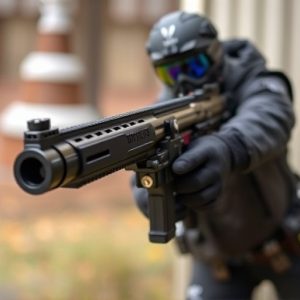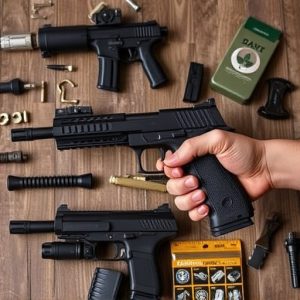Exploring Effective Non-Lethal Home Defense Weapons and Deterrents
Non-lethal home defense weapons like pepper spray, stun guns, and personal alarms are crucial for s…….
Non-lethal home defense weapons like pepper spray, stun guns, and personal alarms are crucial for safeguarding homes and families effectively and ethically. Pepper spray temporarily blinds and immobilizes attackers by causing intense inflammation and pain. Stun guns deliver a powerful electric shock, disrupting muscle control. Personal alarms emit a loud noise to startle and disorient intruders, often deterring them from continuing their illegal activity. These weapons are legal, accessible, and provide a safer option for homes with children or pets compared to traditional firearms. It's essential to be legally compliant, proficient in their use, and understand the operational parameters of these devices. Proper training and awareness of local laws ensure they can be deployed effectively and safely in emergency situations, enhancing home security without causing irreversible harm. These non-lethal options are a practical addition to any home defense strategy, offering a non-violent but potent deterrent against intruders.
When it comes to safeguarding one’s home and person without resorting to fatal force, non-lethal personal defense options stand out as effective alternatives. This article delves into the realm of non-lethal home defense weapons, providing a comprehensive look at their applications and effectiveness. From the incapacitating sprays of pepper spray to the electrifying deterrence of stun guns and Tasers, and the alarming presence of personal alarms, we explore how these tools can be integrated into your defense strategy, ensuring your safety without lethal consequences. Understanding these options is key to making informed decisions for your home security and personal protection.
Understanding Non-Lethal Home Defense Options: An Overview
Non-lethal home defense weapons offer a viable alternative for those seeking to protect their homes and loved ones without resorting to fatal force. These options are designed to incapacitate an intruder, providing a means of self-defense that aligns with the ethical and legal considerations of non-fatal engagement. Pepper spray, stun guns, and personal alarm systems are among the most commonly utilized non-lethal defense weapons within households. Pepper spray, for instance, utilizes oleoresin capsicum to temporarily impair an assailant’s vision, respiratory system, and ability to move, effectively deterring aggressive behavior without causing permanent harm. Stun guns deliver a high-voltage, low-ampere electric shock, which can overwhelm an intruder’s muscular control, rendering them incapacitated while also being less harmful than lethal alternatives. In selecting the appropriate non-lethal home defense weapon, it is crucial to consider factors such as legal regulations, individual comfort with the device, and the potential for using these tools in a variety of scenarios. Proper training is also essential to ensure effective deployment of these devices. Additionally, it’s important to familiarize oneself with the proper usage and storage of non-lethal weapons to maximize their effectiveness and safety for all parties involved. Understanding the range, limitations, and maintenance requirements of each option can enhance one’s preparedness and confidence in employing non-lethal home defense weapons when faced with an intruder.
Pepper Spray: A First Line of Defense for Personal Safety
Non-lethal personal defense options play a pivotal role in deterring potential threats and ensuring personal safety without causing irreversible harm. Among these, pepper spray stands out as an accessible and effective first line of defense. This highly effective irritant can incapacitate an attacker, providing precious time to escape or for law enforcement to intervene. Pepper spray is a non-lethal home defense weapon that contains a powerful oleoresin capsaicinoid (OC) compound derived from chili peppers, which induces intense inflammation and pain upon contact with the eyes, skin, and respiratory system of an assailant. Its range and effectiveness make it suitable for various situations, from personal protection to defense against intruders in one’s home. The ease of use and legal availability across many jurisdictions further cement its status as a reliable component of a comprehensive safety plan, offering users a non-lethal alternative that is both affordable and effective in deterring aggression. Users are encouraged to familiarize themselves with local regulations and to practice using their pepper spray in controlled environments to ensure proficiency when it matters most.
Stun Guns and Tasers: Electric Shock Devices for Home Protection
Non-lethal personal defense weapons, such as stun guns and Tasers, serve as effective deterrents for home protection. These electric shock devices are designed to incapacitate an intruder temporarily by delivering a high-voltage, low-ampere electrical charge. Stun guns typically resemble traditional firearms but without the projectile ammunition, instead delivering the shock upon direct contact with the attacker. Tasers, on the other hand, are equipped with conductive probes that can be deployed from a distance, allowing for a safe disengagement if necessary. Both stun guns and Tasers are categorized as non-lethal home defense weapons and are favored for their safety in crowded households with children or pets, where traditional firearms pose a higher risk of accidental injury or fatality.
When considering the integration of stun guns or Tasers into your home security plan, it’s crucial to understand the legal implications, as well as to receive proper training on their usage. This ensures that you can effectively and safely deploy them in an emergency situation. Additionally, these devices should complement other security measures, such as alarm systems and surveillance cameras, to provide a comprehensive approach to non-lethal home defense. The effectiveness of stun guns and Tasers lies not only in their incapacitating power but also in their ability to deter would-be intruders from even attempting to enter a residence protected by these non-lethal home defense weapons.
Personal Alarms: Deterrents That Announce Your Intention to Defend
Personal alarms serve as highly effective deterrents within the realm of non-lethal personal defense mechanisms, signaling one’s intent to defend without resorting to physical violence. These devices are specifically designed to draw attention and disorient an aggressor, creating an audible sound that can be startling and disconcerting for would-be intruders. The shrill, alarming noise they emit acts as a clear announcement of your resolve to protect yourself and your property, often leading attackers to retreat. By incorporating a personal alarm into your self-defense strategy, you are equipping yourself with a tool that can effectively deter threats, making it a valuable addition to your arsenal of non-lethal home defense weapons. These alarms, which can be carried conveniently on keychains or worn as bracelets, are user-friendly and provide an additional layer of security for individuals in vulnerable situations. Their presence alone can be a significant deterrent, as potential assailants may reconsider their actions upon realizing that the target is prepared to respond forcefully within the bounds of safety and legality. As such, personal alarms are an indispensable component of a comprehensive non-lethal home defense strategy, providing a means to safeguard one’s person and possessions without causing harm.
Home Security Systems: Integrating Non-Lethal Deterrents into Your Defense Strategy
Non-lethal personal defense strategies within the home are becoming increasingly popular as individuals seek to protect themselves and their loved ones without resorting to lethal force. Home security systems often serve as a first line of defense, with cameras and alarms deterring potential intruders. However, these systems may not always be enough to neutralize a threat should one breach the home’s perimeter. Integrating non-lethal home defense weapons into your strategy can provide an additional layer of protection that incapacitates an intruder without causing permanent harm.
Pepper spray and stun guns are two effective non-lethal options that can be employed in a home defense scenario. Pepper spray, for instance, is highly effective at temporarily blindings an attacker, buying valuable time to escape or contact authorities. Stun guns deliver a high-voltage electric shock that can incapacitate an intruder long enough to retreat to a safe location. These tools should be accessible and familiar to all household members, ensuring they are ready for use in an emergency. It’s also crucial to understand the legal implications and local laws regarding non-lethal defense weapons to ensure their use is both compliant and effective within your jurisdiction. By incorporating non-lethal home defense weapons into your overall security strategy, you can enhance the safety of your residence and provide yourself with a viable option for protecting against harm.


